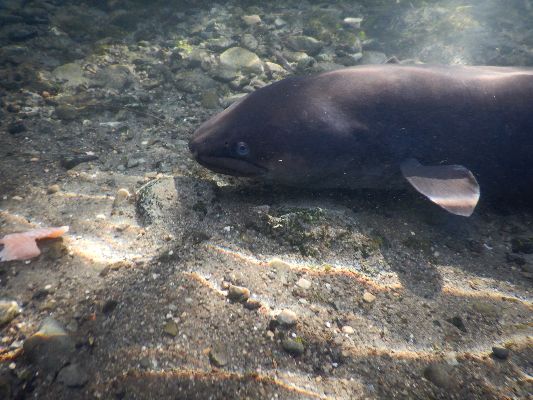Wairarapa's water critters were getting pampered this week.

Three gabion cages will provide a safe habitat for eels in Masterton's Makoura waterway.
Further downstream, students at Kahutara School in South Wairarapa have also been tending to the local aquatic fauna.
Masterton District Council [MDC] has worked with Greater Wellington Regional Council [GWRC] to have the rock-filled cages after work carried out on erosion near the bridge reduced habitat for eels and other fish, and aquatic invertebrates.
The cages, supplied by MDC and installed and filled without charge by Citycare, are designed to give fish and invertebrates space to hide amongst the stones. The cages also contain pipes to be used as caves by larger eels.
“They’re designed to provide a habitat that replicates the natural conditions fish appreciate and help replace some of the habitat that was lost due to the erosion protection works,” MDC senior advisor Phil Evans said.
“Amongst the stones, fish and invertebrates will find it dark, and safe from predators.”
Greater Wellington freshwater ecologist Alton Perrie said the gabion cages were a good solution to trial to help mitigate the habitat lost for the eels and other aquatic life.
“Eels, in particular, are a feature of the aquatic life in the Makoura stream and are considered a taonga [treasure] by the community living beside the stream.
“Members of the community can be regularly seen congregating at the stream to feed and observe the eels.
“We hope the gabion cages will provide habitat to allow the eel population and other aquatic life to thrive.”
Further south, Kahutara School pupils were adding their support to a long term ecology programme.
For the past three years, students have been helping develop a wetland after participating in the Whitebait Connection programme which was led by the Mountains to Sea Wellington group, also supported by GRWC.
The land where the wetland has been developed was donated by grandparents of a former student in 2017 and the restoration work had been integrated into the school's curriculum.
Micheline Evans, GWRC biodiversity advisor, said three years on students were already seeing the positive changes.
This included flourishing locally sourced kowhai, kahikatea, harakeke, cabbage trees, black beech, and frequent visits from kotare, ducks, and the occasional white heron.
Evans said educational and environmental projects provided practical opportunities to support the student's wellbeing while setting the region up for success "by leaving a healthy and thriving biodiversity legacy".
Kahutara School deputy principal Hamish McRae agreed.
"It's the small things like our students all picking a tree to research and name that build their sense of connection and belonging with the area.
"Some of these children will grow up to become farmers, so it's awesome they can begin to appreciate the value of these activities.
"We can see children making connections between the conservation work they are already doing on their family farms, like trapping and planting."
He said the school couldn't have transformed this once-was muddy paddock into a thriving ecosystem without further support from numerous community groups, like South Wairarapa Rotary and Featherston's Own Charitable Trust.
The school was recently visited by Scottish dragonfly experts, Ruary MacKenzie Dodds and Kari de Koenigswarter who showed students that the wetland is a hotspot of baron dragonfly larvae.
There are also plans to include QR codes on trees along a community track around the wetland for visitors to learn about species' history.
Greater Wellington councillor Adrienne Staples said she hoped the venture inspired others to start their own projects.
"The young generation is paving the way for a greener, healthier and a more resilient future through kaupapa like these."
More information about GWRC's sustainable schools programmes can be found online at gw.govt.nz/stuff-for-schools.



 Ramzy Baroud: Shifting Allegiances - The Role Of Palestine In US Domestic And Foreign Policy
Ramzy Baroud: Shifting Allegiances - The Role Of Palestine In US Domestic And Foreign Policy Binoy Kampmark: Back To Tried Failures - The New Offensive On Gaza
Binoy Kampmark: Back To Tried Failures - The New Offensive On Gaza Keith Rankin: Donald Trump's Views On The World Trading-System
Keith Rankin: Donald Trump's Views On The World Trading-System Adrian Maidment: The Polls
Adrian Maidment: The Polls Peter Dunne: Dunne's Weekly - ACC Rules On Volunteers Need To Change
Peter Dunne: Dunne's Weekly - ACC Rules On Volunteers Need To Change Gordon Campbell: On Luxon’s Survival Chances, And The India FTA
Gordon Campbell: On Luxon’s Survival Chances, And The India FTA